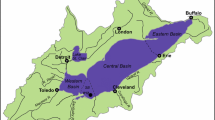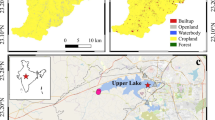Abstract
A high-resolution geochemical profile from a 5,500-year-old sediment core of Lake Lehmilampi in eastern Finland was analyzed to study long-term trends and variability in element concentrations and accumulation rates. The accumulation rates of all studied elements followed the same trend, responding to changes in the total sedimentation rate. Concentration profiles differed among elements and showed considerable variation over time. Principal components analysis (PCA) was used on the concentration data to identify groups of elements that have similar geochemical controls. The first principal component was influenced by changes in mineral matter accumulation, and it incorporated elements that are associated with stable allochthonous minerals (such as Mg, K, Cs, Rb, Li, Ti and Ga), as well as elements in forms that become diluted when mineral matter increases (e.g., S, Fe and Mn). The second and third principal components showed that a large proportion of the variance was accounted for by elements with continuously increasing or decreasing concentrations related to pedogenetical development of the catchment soil. In the case of Hg, Pb and Cd, however, accumulation rates increased faster at the surface than is simply accounted for by changes in total sedimentation rates. For Cu, Cr, Ni and Zn, concentrations increased over the past 150 years, but there were no indications of a significant addition due to atmospheric deposition. These elements had more variable concentrations before the mid nineteenth century than after, as did elements that are often used for normalization. These findings suggest that lake sediments may not properly reflect the history of atmospheric metal deposition in remote areas.






Similar content being viewed by others
References
Boyle JF, Mackay AW, Rose NL, Flower RJ, Appleby PG (1998) Sediment heavy metal record in Lake Baikal: natural and anthropogenic sources. J Paleolim 20:135–150
Boyle JF, Rose NL, Appleby PG, Birks HJB (2004) Recent environmental change and human impact on Svalbard: the lake-sediment geochemical record. J Paleolim 31:515–530
Brännvall M-L, Bindler R, Emteryd O, Renberg I (2001) Four thousand years of atmospheric lead pollution in northern Europe: a summary from Swedish lake sediments. J Paleolim 25:421–435
Chillrud SN, Bopp RF, Simpson HJ, Ross JM, Shuster EL, Chaky DA, Walsh DC, Choy CC, Tolley L-R, Yarme A (1999) Twentieth century atmospheric metal fluxes into Central Park Lake, New York City. Environ Sci Technol 33(5):657–662
Dean W (2002) A 1500-year record of climatic and environmental change in Elk Lake, Clearwater County, Minnesota II: geochemistry, mineralogy, and stable isotopes. J Paleolim 27:301–319
Drobner U, Tyler T (1998) Conditions controlling relative uptake of potassium and rubidium by plants from soils. Plant Soil 201:285–293
Egli M, Mirabella A, Sartori G, Fitze P (2003) ä1 Weathering rates as a function of climate: results from a climosequence of the Val Genova (Trentino, Italian Alps). Geoderma 111:99–121
Fitzgerald WF, Engstrom DR, Mason RP, Nater EA (1998) The case for atmospheric mercury contamination in remote areas. Environ Sci Technol 32:1–7
Gélinas Y, Lucotte M, Schmit JP (2000) History of the atmospheric deposition of major and trace elements in the industrialized St. Lawrence Valley, Quebec, Canada. Atmos Environ 23:1797–1810
Haltia-Hovi E, Saarinen T, Kukkonen M (2007) A 2000-year record of solar forcing on varved lake sediment in eastern Finland. Quaternary Sci Rev 26:678–689
Haltia-Hovi E, Nowaczyk N, Saarinen T, Plessen B (2010a) Magnetic properties and environmental changes recorded in Lake Lehmilampi (Finland) during the Holocene. J Paleolim 43:1–13
Haltia-Hovi E, Nowaczyk N, Saarinen T (2010b) Holocene palaeomagnetic secular variation recorded in multiple lake sediment cores from eastern Finland. Geophys J Int 180:609–622
Han Y, Jin Z, Cao J, Posmentier ES, An Z (2007) Atmospheric Cu and Pb deposition and transport in lake sediments in a remote mountain area, Northern China. Water Air Soil Pollut 179:167–181
Hermanson MH (1998) Anthropogenic mercury deposition to Arctic lake sediments. Water Air Soil Pollut 101:309–321
Jersak J, Amundson R, Brimhall G Jr (1995) A mass balance analysis of podzolization: examples from the northeastern United States. Geoderma 66:15–42
Karlsson S, Grahn E, Düker A, Bäckström M (2006) Historical pollution of seldom monitored trace elements in Sweden–part A: sediment properties and chronological indicators. J Environ Monit 8:721–731
Koinig KA, Shotyk W, Lotter AF, Ohlendorf C, Sturm M (2003) 9000 years of geochemical evolution of lithogenic major and trace elements in the sediment of an alpine lake—the role of climate, vegetation, and land-use history. J. Paleolim. 30:307–320
Kolak JJ, Long DT, Beals TM, Eisenreich SJ, Swackhamer DL (1998) Anthropogenic inventories and historical and present accumulation rates of copper in Great Lake sediments. Appl Geochem 13:59–75
Lorey P, Driscoll CT (1999) Historical trends of mercury deposition in Adirondack Lakes. Environ Sci Technol 33(5):718–722
Lundström US, van Breemen N, Bain D (2000) The podzolization process. A review. Geoderma 94:91–107
Luukkonen E (2003) Geological map of Finland. Sheet 4321, Nurmes. Geological Survey of Finland
Mäkinen J (2005) A comparison of the geochemistry of aquatic sediments and the fine (<63 μm) till fraction in Finland. Geochem Explor Environ Anal 5:159–167
Mäkinen J, Pajunen H (2005) Correlation of carbon with acid-soluble elements in Finnish lake sediments: two opposite composition trends. Geochem Explor Environ Anal 5:169–181
Miettinen A (1996) Pielisen jääjärven kehityshistoria (The history of the Pielinen ice lake). Terra 108:14–19 (in Finnish)
Norton SA, Bienert RW, Binford MW, Kahl J (1992) Stratigraphy of total metals in PIRLA sediment cores. J Paleolim 7:191–214
Norton SA, Wilson T, Handley M, Osterberg EC (2007) Atmospheric deposition of cadmium in the northeastern USA. Appl Geochem 22:1217–1222
Nriagu JO (1996) A history of global metal pollution. Science 272(5259):223–224
Nyholm NEI, Tyler G (2000) Rubidium content of plants, fungi and animals closely reflects potassium and acidity conditions of forest soils. Forest Ecol Manag 134:89–96
Ojala AEK, Francus P (2002) Comparing X-ray densitometry and BSE-image analysis of thin section in varved sediments. Boreas 31(1):57–64
Ojala AEK, Saarinen T (2002) Paleosecular variation of the Earth’s magnetic field during the last 10,000 years based on the annually laminated sediment of Lake Nautajärvi, central Finland. Holocene 12:391–400
Olsson MT, Melkerud P-A (2000) Weathering in three podzolized pedons on glacial deposits in northern Sweden and central Finland. Geoderma 94:149–161
Outridge PM, Stern GA, Hamilton PB, Percival JB, McNeely R, Lockhart WL (2005) Trace metal profiles in the varved sediment of an Arctic lake. Geochim Cosmochim Acta 69(20):4881–4894
Radojević M, Bashkin VN (2006) Practical environmental analysis, 2nd ed. RSC Publishing, USA, p 457
Reimann C, De Caritat P (2000) Intrinsic flaws of element enrichment factors (EFs) in environmental geochemistry. Environ Sci Technol 34:5084–5091
Reimann C, De Caritat P (2005) Distinguishing between natural and anthropogenic sources for elements in the environment: regional geochemical surveys versus enrichment factors. Sci Total Environ 337:91–107
Renberg I (1981) Formation, structure and visual appearance of iron-rich varved lake sediments. Verh Internat Verein Limnol 21:94–101
Renberg I (1986) Concentration and annual accumulation values of heavy metals in lake sediments: their significance in studies of the history of heavy metal pollution. Hydrobiologia 143:379–385
Rognerud S, Fjeld E (2001) Trace element contamination of Norwegian lake sediments. Ambio 30(1):11–19
Rognerud S, Skotvold T, Fjeld E, Nortan SA, Hobæk A (1998) Concentrations of trace elements in recent and preindustrial sediments from Norwegian and Russian Arctic Lakes. Can J Fish Sci 55:1512–1523
Rognerud S, Hongve D, Fjeld E, Ottesen (2000) Trace metal concentrations in lake and overbank sediments in southern Norway. Environ Geol 39(7):723–732
Salminen (ed.) (2005) Geochemical Atlas of Europe. Part 1: background information, methodology and maps. Geological Survey of Finland, Espoo. www.gtk.fi/publ/foregsatlas/. Electronic version downloaded 2009-11-01
Sauer D, Sponagel H, Sommer M, Giani L, Jahn R, Stahr K (2007) Review article podzol: soil of the year 2007 a review on its genesis, occurrence, and functions. J Plant Nutr Soil Sci 170:581–597
Selig U, Leipe T (2008) Stratigraphy of nutrients and metals in sediment profiles of two dimictic lakes in North-Eastern Germany. Environ Geol 55:1099–1107
Solovieva N, Jones VJ (2002) A multiproxy record of holocene environmental changes in the central Kola peninsula, northwest Russia. J Quaternary Sci 17(4):303–318
Szefer P, Kusak A, Szefer K, Jankowska H, Wolowicz M, Ahmed Ali A (1995) Distrubution of selected metals in sediment cores of Puck Bay, Baltic Sea. Mar Pollut Bull 30:615–618
Tyler G (2004) Vertical distribution of major, minor and rare elements in a Haplic Podzol. Geoderma 119:277–290
Tylmann W (2005) Lithological and geochemical record of anthropogenic changes in recent sediments of a small and shallow lake (Lake Pusty Staw, northern Poland). J Paleolim 33:313–325
Verta M (1989) History of heavy metal pollution in Finland as recorded by lake sediments. Sci Total Environ 87:1–18
Virkanen J, Korhola A, Tikkanen M, Blom M (1997) Recent environmental changes in a naturally acidic rocky lake in southern Finland, as reflected in its sediment geochemistry and biostratigraphy. J Paleolim 17:191–213
Wu Y, Hou X, Cheng X, Yao S, Xia W, Wang S (2007) Combining geochemical and statistical methods to distinguish anthropogenic source of metals in lacustrine sediment: a case study in Dongjiu Lake, Taihu Lake catchment. China Environ Geol 52:1467–1474
Wyttenbach A, Furrer V, Tobler L (1995) The concentration ratios plant to soil for the stable elements Cs, Rb and K. Sci Total Environ 173–174:361–367
Yang H, Rose N (2005) Trace element pollution record on some UK lake sediments, their history, influence factors and regional differences. Environ Int 31:63–75
Acknowledgments
Financial support for this work was provided by the Graninge Foundation, the Faculty Board at the Linnaeus University, the Knowledge Foundation (KK-stiftelsen) and the Academy of Finland (grant 123724). We would like to thank Jari Mäkinen at the Geological Survey of Finland for proving us with the local till data, and Ullrika Sahlin at the Linnaeus University for her review of the statistical analyses.
Author information
Authors and Affiliations
Corresponding author
Rights and permissions
About this article
Cite this article
Augustsson, A., Peltola, P., Bergbäck, B. et al. Trace metal and geochemical variability during 5,500 years in the sediment of Lake Lehmilampi, Finland. J Paleolimnol 44, 1025–1038 (2010). https://doi.org/10.1007/s10933-010-9471-z
Received:
Accepted:
Published:
Issue Date:
DOI: https://doi.org/10.1007/s10933-010-9471-z




